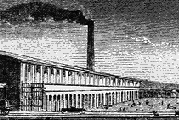|
________________________________________________________
________________________________________________________
(1) Keynes and Oxbridge The heroic entrepreneurs of Schumpeter are resurrected, only slightly less heroically, in the General Theory (1936) of John Maynard Keynes. Investment, in the Keynesian system, is an independent affair contingent upon financial conditions and the "animal spirits" of entrepreneurs. Keynes did not extend his macroeconomic theory into the longer run. By this we mean that Keynesian macroeconomic equilibrium was contingent upon a given stock of capital. But as there is positive investment in Keynes's equilibrium, then there must be changing capital stocks. Thus, the macroeconomic equilibrium of today will be different from the macroeconomic equilibrium of tomorrow. Keynesian macroeconomic equilibrium could not, in this sense, be "permanent"; it is merely "short-run". Sir Roy F. Harrod was perhaps the first to notice this and it was Harrod (1936, 1939, 1948) who initiated the move from short-run macroeconomic equilibrium to longer-run theories of growth and cycles. We have referred to this elsewhere as the "Oxbridge" research program" research program, in recognition of the fact that this program was initiated by Oxford economists Roy Harrod and John Hicks, and continued by Cambridge economists such as Joan Robinson, Nicholas Kaldor and Luigi Pasinetti. Although developing a Keynesian theory of business cycles was arguably the primary objective of the Oxbridge researchers, it is perhaps their contributions to growth theory that have had the wider impact. It is interesting to note that the Oxbridge program was the first such attempt in the English-speaking world since John Stuart Mill a full century earlier! The two contributions that kicked off the growth side of the program were the models of Roy Harrod (1939) and Evsey Domar (1946). Although their final solution happens to be the same, the Harrod and Domar models are actually constructed differently, and thus we consider them separately. We turn to the Cantabrigian (Kaldor, Robinson, Pasinetti, etc.) contributions later. For those wishing to skip the intermediate steps, we draw your attention to Section (5) which contains the "modern" (but inaccurate) version of the Harrod-Domar growth model.
|
All rights reserved, Gonšalo L. Fonseca

